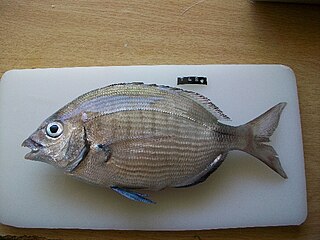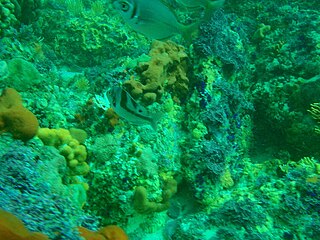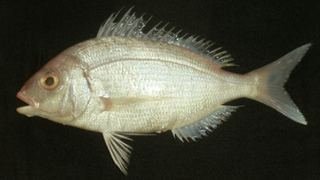
Chrysoblephus gibbiceps, the red stumpnose, red stumpnose seabream or Miss Lucy, is a species of marine ray-finned fish belonging to the family Sparidae, the seabreams and porgies. This fish is endemic to the southwestern Indian Ocean off the coast of South Africa. The International Union for Conservation of Nature classifies this species as Endangered.

Chrysoblephus laticeps, the red roman or roman seabream, is a species of marine ray-finned fish belonging to the family Sparidae, the seabreams and porgies. This fish is endemic to Southern Africa, ranging from Namibia to the Eastern Cape.

Acanthopagrus is a genus of marine ray-finned fishes belonging to the family Sparidae, the sea breams and porgies. The fish in this genus are found in the Indian and western Pacific Oceans.

Acanthopagrus berda, the goldsilk seabream, sly bream, picnic seabream, black sea bream, black porgy, picky bream, silver bream or river bream, is a species of ray-finned fish belonging to the family Sparidae, the sea breams and porgies. This species is found in the Indian Ocean.

Cheimerius is a monospecific genus of marine ray-finned fish belonging to the family Sparidae, the seabreams and porgies. The only species in the genus is Cheimerius nufar, the santer seabream, santer or soldier, of the Indian Ocean.

Chrysoblephus puniceus, the slinger seabream, is a species of marine ray-finned fish belonging to the family Sparidae, the seabreams and porgies. This species is found in the southwestern Indian Ocean where it is endemic to Southern Africa.

Diplodus hottentotus, the zebra, is a species of marine ray-finned fish belonging to the family Sparidae, which includes the seabreams and porgies. This fish is found in the Western Indian Ocean off Southern Africa.

Diplodus capensis, the Cape white seabream or blacktail seabream, is a species of marine ray-finned fish belonging to the family Sparidae, which includes the seabreams and porgies. This fish is found around the coasts of Southern Africa.

Chrysoblephus anglicus, the Englishman seabream, is a species of marine ray-finned fish belonging to the family Sparidae, the seabreams and porgies. This fish is endemic to Southern Africa.

Chrysoblephus cristiceps, the daggerhead seabream or dageraad, is a species of marine ray-finned fish belonging to the family Sparidae, the seabreams and porgies. This fish is endemic to the southwestern Indian Ocean and southeastern Atlantic Ocean off South Africa. This species is assessed as being Critically Endangered bt the International Union for Conservation of Nature.
Chrysoblephus lophus, the false red stumpnose or the false Englishman, is a species of marine ray-finned fish belonging to the family Sparidae, the seabreams and porgies. This species is endemic to the South African waters of the southwestern Indian Ocean.

Pagellus natalensis, the Natal pandora, is a species of marine ray-finned fish belonging to the family Sparidae, which includes the seabreams and porgies. This species is found in the southwestern Indian Ocean.

Acanthopagrus bifasciatus, the twobar seabream, is a species of marine ray-finned fish belonging to the family Sparidae, the sea breams and porgies. This species is found in the northwestern Indian Ocean.
Argyrops filamentosus, the soldierbream, is a species of marine ray-finned fish belonging to the family Sparidae, the seabreams and porgies. This fish is found in the Western Indian Ocean.

Evynnis ehrenbergii is a species of marine ray-finned fish belonging to the family Sparidae, which includes the seabreams and porgies. This species is found in the Eastern Atlantic Ocean and the Mediterranean Sea.

Pachymetopon is a genus of marine ray-finned fishes belonging to the family Sparidae, which includes the seabreams and porgies. The species in this genus are endemic to Southern Africa.

Pachymetopon grande, the bronze seabream or blue hottentot, is a species of marine ray-finned fishes belonging to the family Sparidae, which includes the seabreams and porgies. This species is found in the southwestern Indian Ocean. It is an important spoecies for recreational fisheries in South Africa and for subsistence fisheries too.

Pagellus affinis, the Arabian pandora, is a species of marine ray-finned fish belonging to the family Sparidae, which includes the seabreams and porgies. This species is found in the northern Western Indian Ocean.

Polyamblyodon is a genus of marin ray-finned fishes belonging to the family Sparidae, which includes the seabreams and porgies. The fishes in this genus are found in the Western Indian Ocean.

Polyamblyodon germanum, the German seabream, is a species of marine ray-finned fish in the family Sparidae, which includes the seabreams and porgies. This species is found in the southwestern Indian Ocean.

















